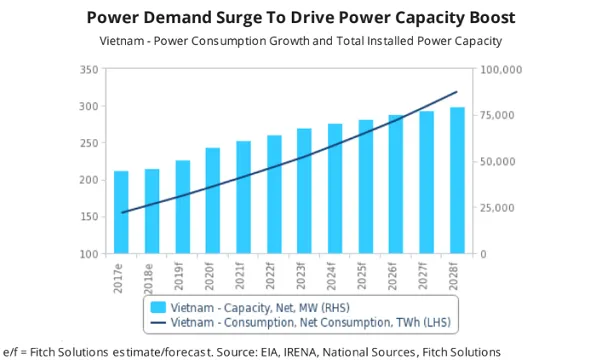
Vietnam capacity additions to hit 33.5GW over demand surge
More power installations are expected as Vietnam seeks to be a manufacturing hub.
As the Vietnamese government seeks to prioritise the development of the power sector, particularly generation from coal and non-hydro renewables, the country’s power capacity is expected to grow by 33.5GW or 5.69% annually between 2019-2028, Fitch Solutions said in a report.
Demand is set to surge as the government attempts to better position Vietnam as a strong alternative manufacturing hub, amidst external uncertainties facing other locations such as China in the ongoing trade war. Vietnam's large manufacturing sector accounts for nearly 17% of GDP.
Additionally, positive demographics and rapid urbanisation will further drive electricity consumption growth rates, which is likely to exceed the speed in which the power sector is expanding at present, Fitch Solutions said. “Given the increasing threat of power shortages as power demand exceeds capacity over the coming years, we believe that the government will look to improve the business and operating environment for the sector, and may look to fast-track certain power projects.”
Recently, the prime minister has urged the State Capital Management Committee and the Ministry of Industry and Trade (MoIT) to simplify the investment procedures for power projects specifically and has also requested for the relevant officials and ministry to submit draft plans to hasten the development of certain key power projects. The State Bank of Vietnam is reportedly also considering to allow power projects to exceed their credit limits so as to complete them on schedule, Fitch Solutions noted.
At present, infrastructure projects in Vietnam are largely driven by government funding or from financial assistance in bilateral and multilateral agencies. However, limited government budget and fiscal capacity to meet project financing requirements have posed some downside risks to the existing project pipeline.
“The government already has a relatively well-developed public-private partnership (PPP) framework to attract private capital, particularly for power infrastructure, but still has room for more transparency and reliability. They are also implementing ongoing reforms and are making efforts to liberalise regulations in the power sector, particularly for renewables, which has attracted some investor interest,” said Fitch Solutions.
New power reforms
One of the major reforms being implemented involves the privatisation and divestment of state-owned enterprises.
State-owned Vietnam Electricity (EVN) has been privatising member enterprises and subsidiaries since the early 2000s, and has completed divestment from its non-core businesses and restructuring its subsidiaries toward production, generation and distribution. “The company is trying to restructure another nine subsidiaries, and expects a complete divestment from core and non-core businesses by end of this year,” noted Fitch Solutions.
EVN will also move to pilot the competitive retail power market, the last phase of the reform process, with the relevant information and technology infrastructure expected to be ready in 2020.
Particularly for renewables, the government has also introduced a new direct power purchase agreement (DPPA), where renewable energy producers can sell and deliver electricity directly to corporate customers. “The Electricity Regulatory Authority of Vietnam (ERAV) has identified a suitable DPPA model for Vietnam, and are now finalising decisions and developing a pilot programme that will be launched later this year,” Fitch Solutions noted.
Boost from renewables incentives
Fitch Solutions noted that feed-in-tariffs (FiTs) for wind and solar in recent years have stimulated more interest in the renewables sector. Effective from 1 November 2018, FiTs for wind were increased to 8.5 cents per kWh for onshore wind power projects and 9.8 US cents per kWh for offshore wind power projects.

Earlier in the year, FiT rates for solar power were also raised to 9.35 cents per kWh for projects that had achieved commercial operation date before June 30 2019. On 29 January 2019, the Ministry proposed a new FiT structure for solar, ranging from 6.59 – 9.85 cents per kWh based on region, type of solar projects, and when the commercial operation date is, suggesting a strategic focus towards solar energy.
Notable, Korean Gas Corporation signed a memorandum of understanding with Energy Capital Vietnam (ECV) to develop a privately-funded LNG regasification terminal, gas supply system and a 3,200MW gas-fired project in Mũi Kê Gà, Bình Thuận.
Enterprise Energy also has plans to build the Ke Ga offshore windfarm in Vietnam with a 3.4GW capacity, which will be the largest offshore wind farm in the region if it comes to fruition. “The project has registered some progress, given that the prime minister has requested for a formal proposal for the project to be included into the country’s power development plan and this is set to boost the wind power project pipeline significantly,” Fitch Solutions added.
Fitch Solutions forecasts power capacity in Vietnam to reach 79.6GW by the end of 2028.








![Cross Domain [Manu + SBR + ABF + ABR + FMCG + HBR + ]](https://cmg-qa.s3.ap-southeast-1.amazonaws.com/s3fs-public/styles/exclusive_featured_article/public/2025-01/earth-3537401_1920_4.jpg.webp?itok=WaRpTJwE)
![Cross Domain [SBR + ABR]](https://cmg-qa.s3.ap-southeast-1.amazonaws.com/s3fs-public/styles/exclusive_featured_article/public/2025-01/pexels-jahoo-867092-2_1.jpg.webp?itok=o7MUL1oO)









 Advertise
Advertise


